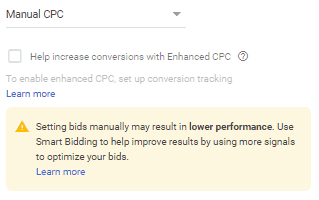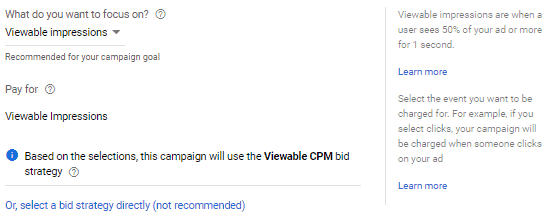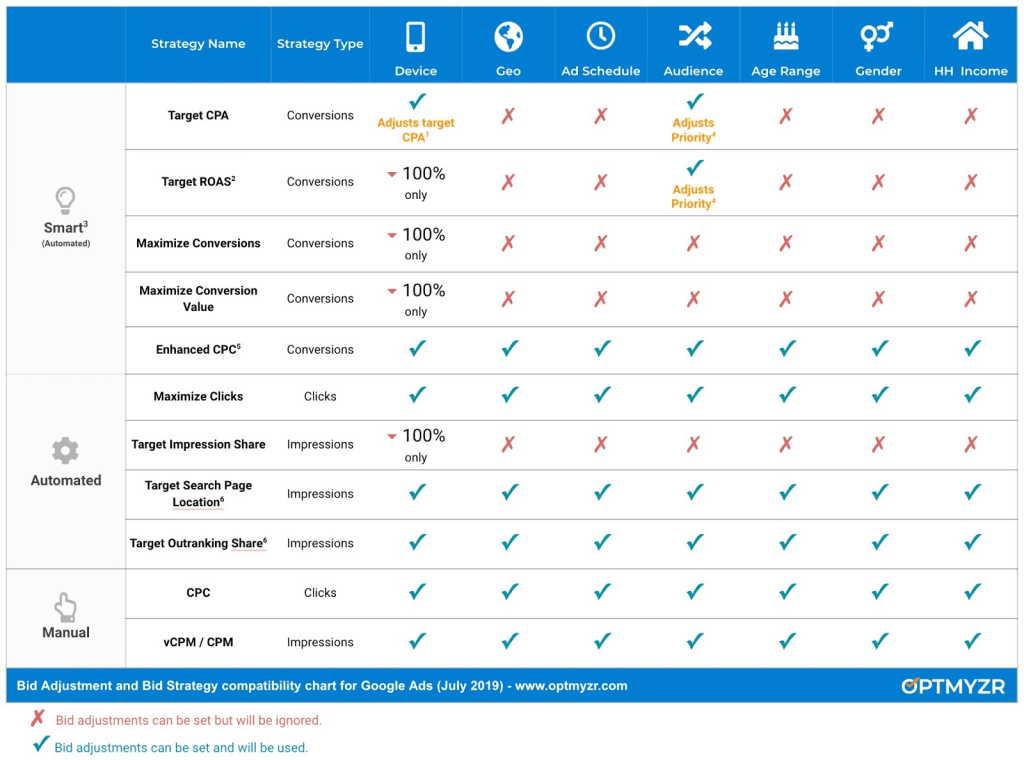Are you wondering which of the leading Google Ads bidding strategies will get the best results for your PPC campaign?
When you set up a PPC campaign on Google Ads, you’ll have the option to choose between different keyword bidding strategies that can make or break your campaign performance.
In our experience, there isn’t one single bidding strategy that works best for every campaign – it’s highly dependent on your own unique circumstances, including industry/niche and campaign goals. However, choosing the bidding strategy that helps you realize campaign objectives is an important part of your overall PPC strategy – one that you can’t afford to overlook.
To help you get started, we’ve created this list of the eleven most important Google Ads bidding strategies that you should know about.
11 Google Ads Bidding Strategies
Manual Bidding Strategies
For digital marketers who wish to be in full control of their keyword bid amounts, manual bidding strategies are the best option. Manual bidding offers marketers the highest degree of oversight on how their ad budgets are allocated, but that also means more time evaluating the performance of keywords, determining how to optimize performance, and actually implementing any bid changes that are necessary.
Manual Cost per Click (CPC)
Manual CPC is available as a bidding strategy option for ad campaigns on both the Google search and Google display networks. With manual CPC bidding, advertisers set their maximum CPC bid for each keyword manually, and the bids don’t change until advertisers go back and change them by hand.

Image: Google cautions advertisers that manual bidding strategies can result in lower campaign performance.
The advantage of manual CPC is that advertisers can customize their bidding strategies exactly as desired. This is great for advertisers running small budget campaigns with a narrow keyword focus, but optimizing your bidding with manual CPC can turn into a lengthy and tedious process as you move on to managing larger campaigns.
Manual Cost per View (CPV)
Advertisers running video ads on the Google display ads can utilize the manual CPV bidding strategy to bid for video views on the Google display network.
On Google Ads, a view is counted when someone either watches 30 seconds of a TrueView in-stream video ad or clicks on a video discovery ad thumbnail to begin watching it. Views are also counted when users interact directly with the video, usually by clicking on an ad overlay or companion banner.
Manual Cost per Thousand Impressions (CPM)
Google only offers manual CPM bidding for video advertising campaigns on the Google display network. Instead of paying for video ad placements on a cost-per-view basis, advertisers can choose to bid for video impressions directly using the manual CPM bidding strategy.
The primary drawback of CPM bidding on the Google display network is that it can be difficult to quantify the benefits of individual ad impressions. An ad impression simply means that your ad was served on the page, but it doesn’t necessarily mean that it was positioned in a good ad slot, that it appeared above the fold, or that the user ever even saw it on the page.
Viewable CPM (vCPM)
Google’s solution to the CPM problem is viewable CPM, a new kind of manual bidding strategy that lets advertisers bid only on impressions that actually appear in viewable positions. An ad is defined as being viewable if it appears on the user’s screen for one second or longer (display ads) or plays for at least two continuous seconds (video ads).

Image: Targeting viewable impressions on the Google display network
Viewable CPM is a good bidding strategy to choose if you’re more concerned with increasing brand recognition and awareness, rather than generating actual clicks to your landing page. The key benefit of vCPM vs. CPM is that you can be sure your display ads are actually being seen by users and creating awareness about your brand.
Automated Bidding Strategies
Automated Google ads bidding strategies are designed to automate the optimization of keyword bidding with respect to specific campaign objectives. Automated bidding can be implemented for a specific ad group, a specific campaign, or across all campaigns for a given advertising account.
Maximize Clicks
When you choose the Google ads bidding strategy known as “maximize clicks”, Google Ads will automatically organize your keyword bidding to help you get as many clicks as possible within your advertising budget. You can use a “standard” strategy to maximize clicks for a single campaign, or a “portfolio strategy” to maximize clicks across multiple ad campaigns.
This bidding strategy also allows advertisers to set a maximum limit on CPC bid amounts to avoid paying too much for individual clicks.
Target Impression Share
The Google ads bidding strategy known as “target impression share” is an automatic bidding configuration that tries to increase how frequently your search ads appear in the area of the page you select.
You can choose to target impressions anywhere on the search results page, among the top 3-4 paid results, or at the absolute top of the search engine results pages. You can choose how frequently you would like your ads to appear for the targeted keyword, and you can also set a maximum CPC bid limit to avoid over-paying for individual clicks.

Image: Customization options for the Target impression share Google ads bidding strategy
Smart Bidding Strategies
Smart bidding strategies use Google’s artificial intelligence and machine learning capabilities to optimize your keyword bids at the time of the keyword auction. Smart bidding uses contextual signals known as “automated bidding signals” to adjust your keyword bid amounts on the fly and help you win ad placements that are most likely to result in conversions.
There are several different bidding strategies that fall under the umbrella of smart bidding, but most of them depend on tracking conversions. Make sure you have conversion tracking properly set up for your Google ads account before you start optimizing with smart bidding strategies.
Target CPA
With a target CPA bidding strategy, advertisers set a target cost-per-action and Google Ads automatically optimizes keyword bidding strategy to achieve as many conversions as possible at or below the target CPA.
Maximize Conversions
A smart bidding strategy that’s set to maximize conversions will use machine learning to optimize keyword bidding and achieve the highest total number of conversions possible while spending your daily budget.

Image: If you’re planning to use smart bidding to maximize conversions, or for other conversion-related bidding strategies, you’ll need to set up conversion tracking on your Google ads account.
If you have bid adjustments currently set up like Geo or time of day adjustments, this type of keyword strategy will cause Google to ignore certain bid adjustments and adjust your bids automatically and in real-time using contextual indicators. Here’s a quick chart provided by Optmyzr on which type of bid adjustments do or don’t affect bids when using different bid strategies.

Target Return on Ad Spend (ROAS)
When you set your Google ads bidding strategy to target ROAS, you will be prompted to set a ROAS target for your advertising campaign. Google’s machine learning algorithm will then optimize your bids to achieve the highest conversion value possible while aiming for your target ROAS.
Maximize Conversion Value
When you set up conversion tracking for your Google Ads account, you’ll be asked to assign relative values to each conversion event. A purchase might be given a high relative value, while capturing an email address would be given a lower conversion value. When you choose this bidding strategy, Google Ads will attempt to optimize your keyword bidding strategy to generate the highest overall value of conversions while spending your ad budget.
Enhanced CPC
Enhanced CPC is really just an extension of manual CPC bidding. When advertisers select this option, they can still manually set budgets for keyword bidding, but Google Ads will automatically control bid adjustments to help get more conversions.
Summary
Google ads bidding strategies can help you optimize your ad spend to generate the outcomes that are most relevant to your campaign goals and objectives.
We hope this resource helps you choose the perfect bidding strategy to make the most of your daily budget and exceed your own expectations for PPC advertising success.
-
CEO Garrett Mehrguth
Did you enjoy this article?
Share it with someone!

